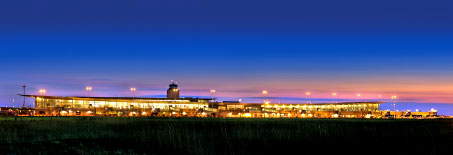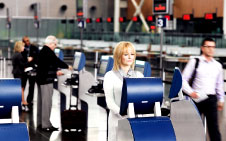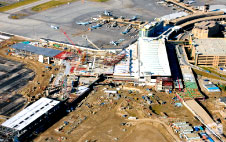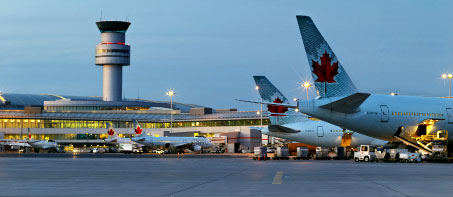
Barry Rempel, President and CEO of Winnipeg Airport Authority: “The architect behind our new airport building centred the design of the terminal on the openness of the people of Manitoba and the connection between our close-knit community and the land. It’s amazing how many of our passengers have recognised this.” (Photograph courtesy of Gerry Kopelow)
Despite continuing economic turbulence weighing heavy on air passenger traffic from key markets in Europe and North America, Canada’s aviation industry continues to experience impressive growth. Throughput at Canadian airports increased by +4.8% in 2012, bringing the total number of passengers to just less than 119 million, and its airport landscape is brimming with development. Modernisation and expansions are taking place nationwide and innovative initiatives are infiltrating every passenger process. Canada’s airports play pivotal roles in their surrounding communities, serving as dominant drivers of economic development and pillars of regional responsibility; Winnipeg Airport Authority for instance invests substantially in community projects such as the Winnipeg Harvest food bank. “Airport city has taken on its own meaning nowadays,” said Barry Rempel, President and CEO of WAA, “but for us what it really means is integrating with the community and being a responsible member of that community.”

Ahead of the development of its CAD$1.5 billion (€1.1bn) modernised terminal, in 2011 Aéroports de Montréal undertook an in-depth examination of the airport’s future. Working alongside multiple consulting organisations including MIT, the study considered the impact of factors such as demographics, population growth, technology and aviation regulation on the airport until 2080 to ensure that further expansion would get maximum value from the airport in the long-term.
The nation’s airport industry is teeming with ingenuity. Montréal-Trudeau Airport has emerged as a key aviation hub connecting Europe to the Americas – its passenger processing strategies and technological firsts serving as a yardstick in fluidity and efficiency. Self-service baggage drops and self-scanning devices, active/inactive bag tags, parallel passenger and baggage tracking, virtual baggage inspection and an automated outbound baggage system are just few of the state-of-the-art solutions available to passengers at the airport, which has also seen the recent CAD$4 million (€3m) implementation of Automated Border Clearance (ABC) kiosks at the Canadian border. “Driven by a desire to continuously improve customer service, Aéroports de Montréal has moved to implement this project with an eye to lowering wait times at international arrivals, mainly for Canadian citizens and permanent residents returning to the country,” said ADMTL’s President and CEO James Cherry. Since September, Automated Passport Control (APC) has also reduced waiting times at US Customs and Border Protection, and before the end of the year ADMTL hopes to transform air travel in the region with the launch of a pre-reservation service, offering accelerated access through domestic and international security screening processes. “We’re trying to influence government policy, and encourage them to be more flexible and open to adopting a model that we’ve seen working elsewhere around the world; processes such as risk-based screening. It’s going to take some time, but I’m sensing openness on their part to that way of thinking,” Cherry said.
Earlier this year, ABC kiosks were also implemented in Toronto Pearson International Airport’s Terminal 3 and Terminal 1, and now the Greater Toronto Airport Authority has begun working with US Customs and Border Protection to introduce kiosks in the pre-clearance areas of both terminals. GTAA has also implemented a simplified connection process that eliminates a baggage claim step when connecting onwards to the US through Terminal 1. “It has been well received, and is a great example of collaboration with United States Customs and Border Protection,” Howard Eng, President and CEO of GTAA, said. “We are currently working with the Canada Border Service Agency to introduce an International To Domestic connection programme. This connection process would allow qualified passengers to no longer claim their luggage and in some cases not be rescreened.”
Widespread development
Following the completion in 2008 of its 10-year Airport Development Program – which saw the development of a new runway, upgraded taxiway system and the brand new Terminal 1 at Toronto Pearson Airport – GTAA is now directing its attention towards its Terminal 3. “We are upgrading and refreshing the building to enhance the facilities that will make the passenger’s flow through the airport more efficient and hassle free,” Eng explained. The new infrastructure is giving the airport room to grow, and in the first half of 2013, GTAA experienced a +2.6% increase in passenger traffic. “As a result of our strong financial position, we have been able to lower aeronautical fees for the sixth consecutive year. Last year, we announced a 10% decrease to our landing fees and we have committed to hold these rates for three years,” Eng added.

The airport expansion project – which also includes the construction of a new CAD$600 million (€430m), 14,000-foot runway – is the largest in the history of Calgary International Airport. When complete, the airport will have double the amount of terminal space, 22 additional aircraft gates, and the longest runway in Canada.
At Calgary International Airport, unwavering growth in passenger traffic of +3-5% has fuelled the beginning of the most monumental expansion project in its history. A 1,600-strong construction crew is working around the clock to bring the CAD$2.1 billion (€1.6bn) Airport Development Program to fruition, providing much needed further capacity – vital to the airport partners’ growth and development – and solidifying YYC’s position as an important economic growth generator for the province.
“YYC has more than tripled in size and passenger volume over the last 20 years and in 2013 the airport expects to welcome over 14 million passengers,” said Garth Atkinson, President and CEO of Calgary Airport Authority. The colossal modernisation will see the opening of a new CAD$600 million (€430m) runway in mid-2014 which, at 14,000 feet will become the longest runway in Canada, capable of landing the largest aircraft in the world with fewer payload restrictions. The second aspect of the expansion, the International Facilities Project, incorporates the development of a 183,500sqm new terminal, which will double the amount of space at the airport. The new International Concourse will feature an CAD$80 million (€57m) state-of-the-art baggage handling system, 22 additional departure gates for flights to US and international destinations, and will revolve around sustainable design principles, using geothermal ground source energy to help heat and cool the building, as well as rainwater harvesting tanks. “A positive passenger experience, from curb to gate, is important to the entire YYC community. We will continue to work at ensuring that experience is a positive one for all the passengers that travel through Calgary International Airport,” Atkinson added.
Setting an industry standard

In recent months, Air Canada launched its leisure airline ‘rouge’ with services to Venice and Edinburgh from Toronto Pearson. Air Canada also added services to Istanbul, while Philippines Airlines commenced service to Manila, EgyptAir to Cairo and Aeroflot to Moscow.
Canada’s visionary airport development has not gone unnoticed by the rest of the world. The opening of Winnipeg James Armstrong Richardson International’s striking new terminal in 2011 earned the airport a hoard of esteemed prizes, including a 1st place ranking in the Best Improvement: North America category in ACI’s 2012 Airport Service Quality (ASQ) Awards. “We have really put a focus on exceeding our customers’ expectations, and in doing that, in each of those moments of truth, every interaction with the customer, the efforts of our staff create an extraordinary passenger experience,” Rempel said. “I wouldn’t want to underestimate the impact of all elements of our airport’s infrastructure on our service though. Our brand new terminal is at the forefront of technology and design, with ease of travel and streamlined processes at the centre of everything we do.”
Winnipeg Airport was the first in Canada to adopt an entirely common use infrastructure, and its newly expanded, 55,000sqm terminal is pushing the envelope in terms of industry leading innovation and service for the airport’s five million passengers. Its redesigned security points have reduced Winnipeg’s queue times to the lowest in the country, and the airport was also among the first in Canada to streamline the baggage drop off process, enhancing customer service by allowing passengers to process luggage at a single location without having to locate different bag drops for domestic, transborder or international destinations. “Any passenger – assuming they haven’t already checked-in on their phone or tablet – can check-in at any kiosk, drop their bag anywhere on the belt and head on through security to airside. It’s done all seamlessly, and though complex behind the scenes, the process in completely transparent for the customer. The terminal is completely intuitive; with an open design, it’s very obvious to the customer where they need to be going next,” Rempel commented.
Intelligent design is also enhancing the passenger experience at Montréal-Trudeau Airport, where the Montréal Identity Program has infused facilities with typically Montréal character, while 100% common use facilities have expedited processes. The airport’s emphasis has turned to strengthening its position as an international hub, and, following exponential growth in international traffic, it is once again expanding to increase its capacity. “We have almost completely rebuilt the terminal, with investments exceeding CAD$1.5 billion (€1.1bn). Now, we are again adding capacity for international flights, expanding the check-in area, baggage rooms, and international jetty to meet future needs and maintain the desired level of service.” Cherry explained. “In the first of two phases, we added a double gate for public transport vehicles and we are expanding the apron and parking to provide much more capacity. In the second we will add eight new gates – including six contact gates for wide-body aircraft – bringing total international gates to 19, and will also develop a high-end commercial area. We expect to have more flights and new destinations, and generate more non-aeronautical revenues as a result.” The modern new features should all be operational by summer 2016 and, when completed, will have the capacity to handle up to 23 million passengers. The airport’s priority is now to further expand its route network, and it is hoping to soon begin regular flights to Beijing, Istanbul and Tunisia, as well as services to Brazil and Panama, further augmenting Canada’s connection to the world.







